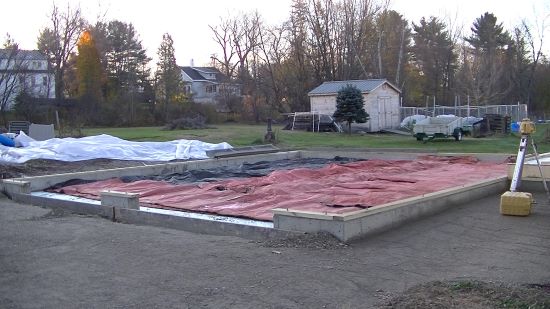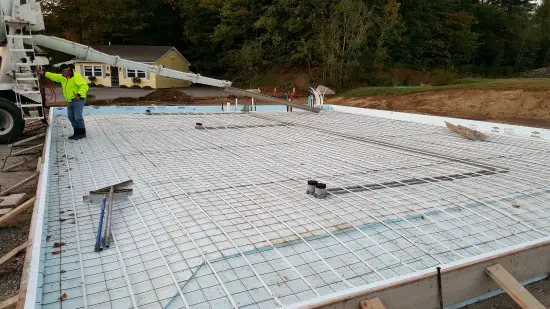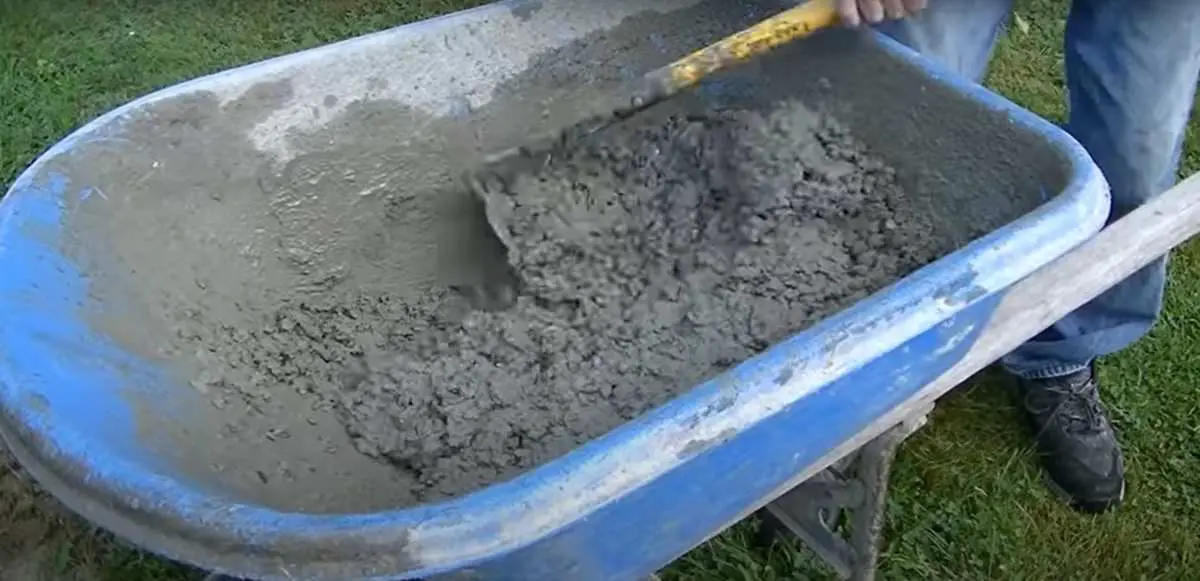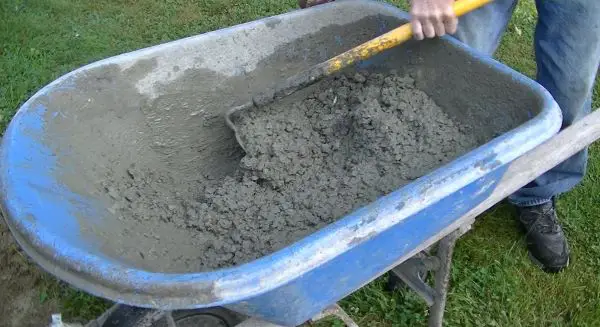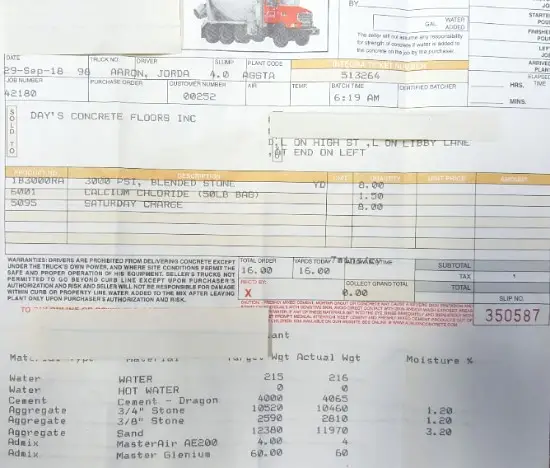My top 9 things to consider
before pouring concrete in cold weather
Pouring concrete in cold weather is something we do a lot of in Maine.
The months of November, December, January, and February usually have many days with temperatures at or below freezing.
Since I make a living pouring concrete floors and slabs, I can't let the cold weather stop me.
We just found what works best during the winter months and we get the concrete poured- and this is the information I am going to share with you.
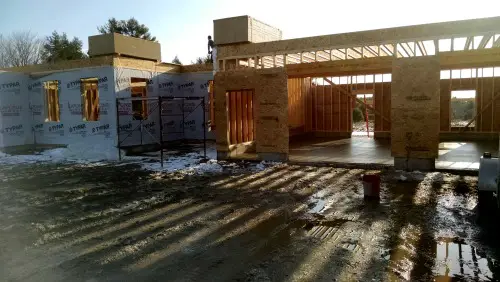
We poured this garage floor in December. The temperature was 26 degrees F when we started to pour at 7am. At 1pm the temperature had risen to 35 F. Notice the snow!
The concrete set-up just fine (alright, maybe a little slow for us), we covered it with insulating blankets and a tarp after troweling smooth. The temperature was forecast to drop below freezing that night.
Here's the 9 things I pay special attention to when we decide to pour concrete in cold weather.
1. SCHEDULE THE POUR IN ADVANCE
I'm in contact with the concrete ready mix company at least 2-3 days in advance and sometimes a week in advance if possible.
The ready-mix company is going to have to be a little flexible with scheduling if the temps are really cold. You may have to delay the pour a day or two if the weather isn't cooperating.
2. THE WEATHER THE DAY OF THE POUR
I like the air temperature to reach at least 28 degrees. I know, that's still below freezing, but if the concrete has hot water mixed with it (120 degrees F) the concrete temperature should be around 65 - 70 F when you dump it on the ground. Then the heat from hydration will be enough to get it to set up (harden).
Fresh concrete or "plastic" concrete will freeze if the air temperature falls below 25 degrees F (-4C).
3. IS THE SUB-BASE FROZEN?
Usually one of these three scenarios is going on when we pour concrete in the winter.
- The excavator is preparing the sub-base just before we are going to pour and protecting the dirt from freezing by using insulating blankets.
- The sub-base was prepared a week, two weeks, or a month ago and was protected by covering it with insulating blankets or a tarp & hay or all three of those.
- The sub-base was prepared well in advance, it froze or has frost in it, and ground heaters are being used to thaw the dirt before we pour.
I always check the sub-base for frost before I pour. If the ground has any frost in it, I won't pour on it. The sub-base has to be completely thawed out before you pour concrete on it. If it's not, the concrete will crack when the ground un-thaws.
4. WHAT IS THE SUB-BASE I'M POURING ON?
If I'm pouring right on dirt or a plastic vapor barrier that's on the dirt then the cold sub-base will draw the heat out of the concrete quite fast.
That tells me I don't want to pour if the temps aren't going to be 28 degrees or higher.
If I'm pouring on styrofoam then the styrofoam will help the concrete hold it's temperature much longer and I can pour with high temps around 26 or 27 degrees.
Note: We've started pouring concrete floors on styrofoam with the temps at 15 degrees at 7am and a high temp of 28 at noon and the concrete set-up just fine.
The concrete temp. was 70 degrees when it showed up on-site, we used a 4000 psi mix and added calcium chloride (an accelerator) to the mixer truck when it was mixing the concrete.
5. WEAR THE APPROPRIATE CLOTHING
Dress in layers, you can always take off a sweatshirt if you get too warm.
I get cold very fast when I pour concrete in extremely cold temperatures.
I wear long-johns, t-shirt, sweatshirt, hooded sweatshirt, and a winter coat for my upper-body and long-johns and jeans for my lower body. I usually put my hood up to keep my head and ears warm and gloves for my hands.
I wear cotton socks and regular rubber boots on my feet, remember the concrete is warm so this helps keep the toes warm.
These are the boots I wear after the pour to keep my feet warm. These are the best boots I've ever owned. They're comfortable, lightweight, very well made, and keep my feet warm!!
6. HAVE ENOUGH HELP TO POUR THE CONCRETE
I like to get the concrete floor or slab poured as quick as possible. I always have at least 1 extra person to help pour than I might have in the summer.
It's freezing out! Get the concrete on the ground fast or it will start loosing temperature while it's sitting in the concrete truck.
Note: if the concrete sits in the chute too long, 5 - 10 minutes, it will freeze to the chute.
7. HAVE SOME TEMPORARY HEAT AVAILABLE
Even if you're pouring right outside, its nice to have some heat if someone needs to warm up their hands, feet, or whole body!
I always carry a kerosene space heater and have a generator in the truck for power. It only takes a minute in front of the heater to get warmed up and comfortable again.
8. AFTER THE CONCRETE IS POURED
Once the concrete floor is poured it will start drying as long as you use the right concrete mix (I use 4000psi) with hot water and an accelerator. You may have to wait 2, 3, or even 5 hours before you get on it to start troweling, but it will dry.
The hardest thing about troweling for me in cold weather is when the wind is blowing. Wind chill doesn't affect concrete like it does people, the wind just seems to go right thru me. brrrrr!
9. ONCE THE CONCRETE IS TROWELED
After the concrete is troweled smooth the next step is to protect it from freezing.
What we've found works best is covering the concrete with insulating blankets, adding a layer of hay over the blankets (maybe 6 inches of hay), and covering the whole pour with a tarp.
This method will keep the slab very warm for days after the pour. Put plenty of lumber on the tarp to keep the wind from blowing it off.
Note: We've gone back 4 days later with the air temperature having been in the teens and 20's and the slab temp under the blankets was 80 degrees F.
That's how we handle pouring concrete in cold weather during the winters of Maine.
Below is a picture of us using the concrete insulating blankets to keep the sub-grade from freezing before we poured the garage floor.
After we poured and troweled this garage floor we used the blankets to protect the concrete from freezing.
If you consider these 9 things before pouring concrete in the cold, you should be in good shape! Just remember, it is possible to pour in the cold, but the correct steps need to be taken in order for it to be successful.
If you'd like to learn more about cold weather concrete, check out this page: What Happens to Concrete when Temperatures are Below Freezing?
If you'd like to learn more about concrete, check out the CONCRETE UNDERGROUND
Mike
What i wear to pour concrete when it is cold
Here is a list of clothing items I wear to stay warm while pouring concrete in freezing temperatures:
Disclaimer: some of the links on this page are Amazon affiliate links. If you click on a link and purchase something from Amazon I may receive a small commission. Thank you.
